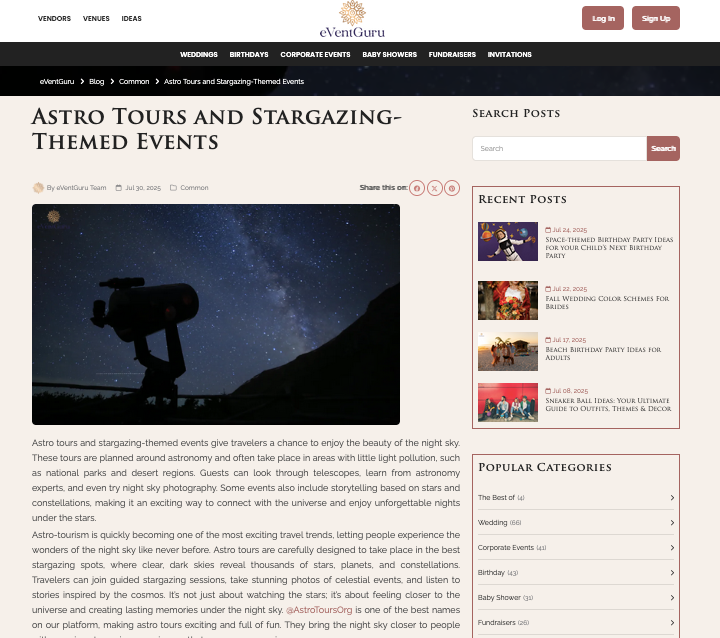
AstroTours.org is thrilled to be featured in eVentGuru’s guide to astro tours and stargazing-themed events — and we’re inviting you to see the night sky like never before.
As astro-tourism continues to rise in popularity, our mobile telescope experiences are turning ordinary nights into unforgettable cosmic adventures. Whether you're planning a wedding under the stars, a corporate retreat, or just looking for a unique date night idea, AstroTours.org brings the universe to your event.
⭐ Why We’re Featured on eVentGuru
The eVentGuru team spotlighted how astro-themed events are taking over the world of destination weddings, birthday parties, luxury retreats, and team-building experiences — and we’re proud to lead the charge.
Here's what makes AstroTours.org stand out:
Guided stargazing nights with expert astronomers
Astrophotography workshops for beginners and pros
Storytelling under the stars with mythology and cosmic facts
Camping with telescopes at certified dark sky sites
Fully mobile setup — we can stargaze almost anywhere
Custom programs for group sizes from 1 to 2,500+
🌠 Host a Private Stargazing Event Anywhere
Whether it’s a luxury wedding in Telluride or a campout with your team in Winter Park, AstroTours.org creates one-of-a-kind private events under the stars. We bring powerful telescopes, knowledgeable astronomers, and flexible programming to any location — from mountaintops to corporate campuses.
We’ve partnered with venues across Boulder, Denver, Winter Park, Breckenridge, Walsenburg, Bailey, and beyond. We even host stargazing at the San Sophia Observatory at the top of the gondola in Telluride!
🔭 Book your private stargazing event today:👉 www.AstroTours.org/privatetours
🌌 Join One of Our Public Tours
Looking for a relaxing night under the stars? We offer nightly stargazing sessions near Boulder with powerful telescopes, hands-on learning, and no hiking required. It’s perfect for families, couples, tourists, and curious minds of all ages.
🚀 Reserve your spot now:👉 www.AstroTours.org/book
📸 Make Your Event Magical
Need inspiration? The eVentGuru blog shared awesome ideas to enhance any starry celebration:
Red light flashlights to preserve night vision
Celestial-themed snacks and cozy seating
Constellation tours guided by expert astronomers
Photo booths with star props for Instagram-worthy moments
Whether you’re planning a space-themed birthday party, a team retreat, or a quiet proposal under the stars, AstroTours adds that “wow” factor.
🔭 Ready to Stargaze? Let’s Plan Something Extraordinary
AstroTours.org is proud to be featured among the top astro-tourism experiences in the USA, and we’d love to show you the magic of the night sky. From romantic evenings to company celebrations, we’re here to help you create an event that’s truly cosmic.
📧 Email us at Luke@AstroTours.org📱 Call/Text: (303) 324-5831

.png)
